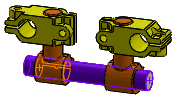| Concentric5(Pin<1>, Rod<1>)
|
 |
These two concentric mates locate the Pin parts relative to the Rod. Because the Pin parts are identical, the upper circular faces of Pin<1> and Pin<2> must always be the same distance from the axis of the Rod.
|
| Concentric6(Pin<2>, Rod<1>)
|
 |
| Distance11(Pin<1>, Clamp<1>)
|
 |
These two distance mates define the distance between the upper circular face of each Pin and the top face of the corresponding Clamp. Because the concentric mates (above) already established that the pins' circular faces cannot move relative to the rod axis, these mates effectively set the vertical position of each clamp.
Because both distance mates currently have the same distance, the clamps' upper faces are aligned (coplanar).
|
| Distance10 (Pin<2>, Clamp<2>)
|
 |
| Coincident21(Clamp<1>, Clamp<2>)
|
 |
This mate sets the clamps' upper faces to be coplanar, which aligns them vertically. This is the same condition set by the mates above.
Thus the Coincident21 mate is redundant with the chain of mates described above (Distance11-> Concentric5-> Concentric6-> Distance10). This mate scheme creates an error because SOLIDWORKS does not allow redundant distance or angle mates.
|